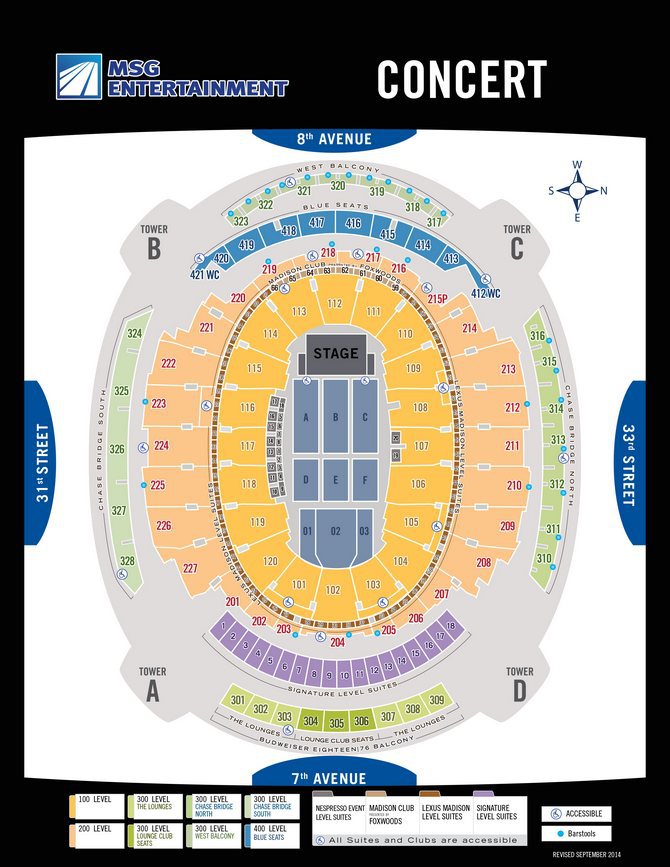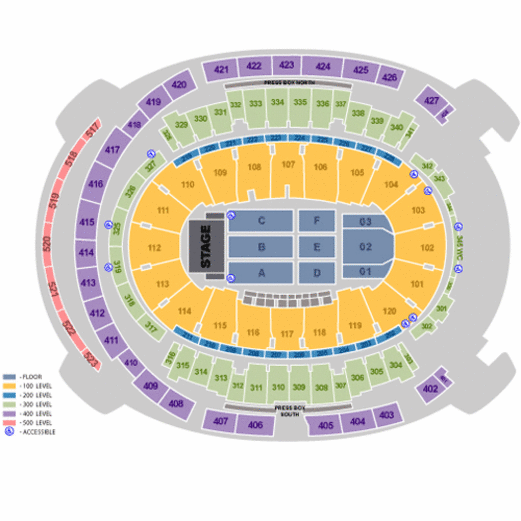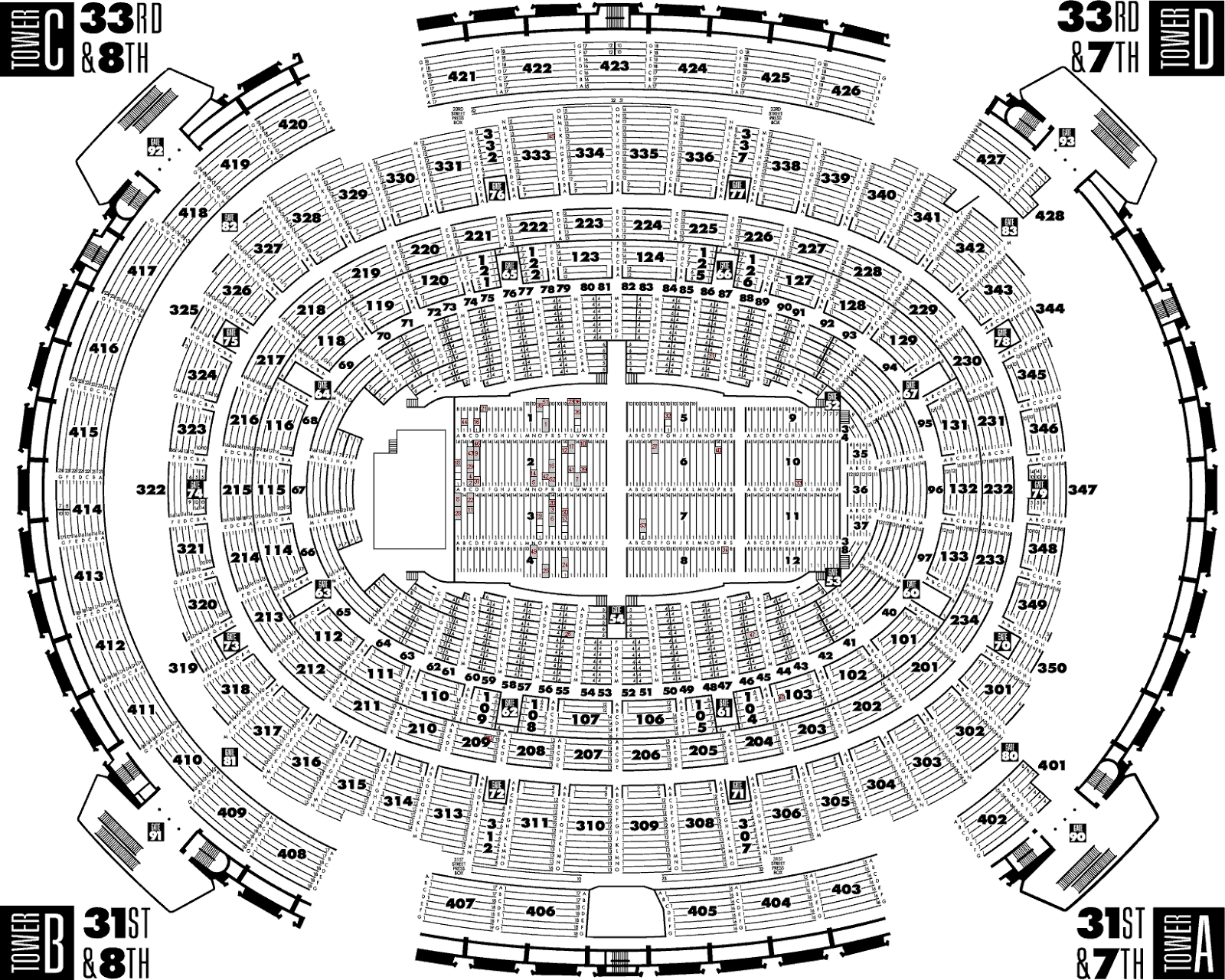Planning a concert at MSG? Understanding the venue layout is key. A seating chart empowers informed decisions.
A concert seating chart for Madison Square Garden (MSG) provides a visual representation of the arena's layout. It depicts the arrangement of seats, including different sections (e.g., orchestra, mezzanine, loge), row numbers, and seat locations. This chart helps patrons select seats based on proximity to the stage, view, and price point. For example, a seating chart will illustrate how seats in the orchestra section offer excellent sightlines, while seats in the upper levels may have slightly reduced visibility.
A detailed seating chart is invaluable for concertgoers. It allows for pre-purchase seat selection, thereby optimizing the concert experience. Understanding the layout beforehand reduces the potential for disappointment or wasted time searching for suitable seats. The chart is also critical for those seeking optimal sightlines and for those on a budget, as different sections offer varying price points. It allows for comparison of seats and ensures a satisfying purchase decision. The chart acts as a powerful tool to ensure the best possible experience for any concert at this legendary venue.
Now that we understand the fundamental importance of a seating chart, let's delve into the nuances of navigating MSG's unique layout. We'll explore specific strategies for making the most informed seat choices, comparing various price ranges and their corresponding advantages and disadvantages. Further, we will analyze how to use the seating chart's information for determining the best possible view.
MSG Concert Seating Chart
Understanding the layout of Madison Square Garden's seating charts is crucial for a positive concert experience. Navigating the complex arrangements is essential for making informed decisions.
- Sections
- Rows
- Seats
- Views
- Pricing
- Accessibility
The seating chart's sections (orchestra, mezzanine, upper levels) determine the proximity to the stage. Rows and individual seats specify location and view. Views vary across the sections, impacting the experience, with orchestra seats offering the best sightlines. Pricing correlates with section and seat location, with premium options generally commanding higher prices. Accessibility features, outlined in the chart, address specific needs. By considering these factors, concertgoers can optimize their experience by selecting appropriate seats aligned with their preferences and budget.
1. Sections
Sections on an MSG concert seating chart are fundamental to understanding the venue's layout and selecting appropriate seats. They delineate distinct areas within the arena, each with varying proximity to the stage, view of the performance, and price points. Careful consideration of these sections is crucial for maximizing the concert experience.
- Proximity to the Stage
Sections closest to the stage, such as orchestra or front mezzanine levels, offer superior sightlines and a more immersive experience, often at a higher price. Conversely, seats in higher sections might provide a less intimate view but may offer a more affordable option. The distance to the stage is a key factor influencing the overall perspective of the performance.
- View of the Stage
Different sections offer varying degrees of unobstructed views. Higher sections may have obstructions, such as structures or other patrons, affecting the overall view. The seating chart explicitly displays how sections impact these obstructions, thus aiding in choosing suitable seating based on the desired view.
- Price Variations
Sections are frequently associated with different price tiers. Seats in premium sections, like orchestra or certain premium mezzanine levels, command higher prices due to their proximity to the stage and better views. The seating chart visually reflects these price differentials, enabling budget planning and informed decisions.
- Accessibility Considerations
Certain sections are specifically designated for accessibility needs. These sections are prominently displayed on the seating chart, ensuring easy identification for individuals requiring specific accommodations. Understanding these designated sections is essential for attendees with special needs.
In summary, the sections on an MSG concert seating chart provide a crucial framework for understanding the venue's spatial organization, influencing seating choices based on factors like proximity, view, and price. By carefully examining these sections, concertgoers can select seats that best meet their preferences and budget, maximizing their enjoyment of the performance.
2. Rows
Rows on an MSG concert seating chart are integral to the overall layout and are crucial for understanding seating arrangements. Rows directly affect seat location and proximity to the stage, impacting the view of the performance. They act as a crucial component of the seating chart, providing a hierarchical structure for seat selection. The numerical designation of rows dictates a sequential progression from front to back, aligning with varying levels of closeness to the action.
Consider a concert at MSG. Row 10 in the orchestra section offers superior sightlines, while Row 30 in the same section might experience some obstruction. Row 1 in the mezzanine could offer an excellent view, yet a particular row further back in the mezzanine could provide a less-optimal view. The row number therefore directly dictates a range of experience, impacting cost and view quality. For example, front rows often command significantly higher prices due to their proximity and unparalleled view. The understanding of rows is essential for making informed choices about where to sit and consequently, what aspect of the experience to prioritize.
In conclusion, rows on an MSG concert seating chart are a vital element. They determine seat location, proximity to the stage, and view quality, significantly influencing the concert-going experience. Understanding how rows relate to different seating sections is paramount for effectively choosing the optimal seats for any given concert. The chart's explicit identification of rows allows a user to visualize and compare the differing experiences offered by various seating locations within the venue.
3. Seats
Individual seats on a Madison Square Garden (MSG) concert seating chart are the fundamental elements in selecting a viewing position. Precise location and identification of seats are critical for optimal concert attendance. The chart provides a detailed breakdown of seating positions, highlighting unique characteristics of each seat.
- Location and Designation
Seats are meticulously marked on the seating chart by both their row and numerical position within the row. This precise designation facilitates straightforward identification and selection. Examples include "Row 12, Seat 18" or similar designations, crucial for accurately referencing a specific seat. Accurate location information is paramount for successful seat selection and provides a detailed spatial overview of the venue.
- View and Obstructions
Specific seat locations directly influence sightlines and the overall view of the performance. The seating chart may depict potential obstructions, such as columns or other structures that might impact visibility from a particular seat. Recognition of potential obstructions enables attendees to choose seats that maximize the view of the performance. For instance, seats near pillars or elevated seating may provide a partially obstructed view.
- Pricing and Value
Seat pricing correlates with location. The seating chart often reflects this pricing structure, visually representing the price difference between premium and standard seating options. Seats in preferred areas, closer to the stage, typically command a higher price. The seating chart is thus a valuable tool for managing budget and prioritizing desired viewing positions.
- Accessibility and Special Needs
Designated seating areas are explicitly marked on the seating chart, aiding individuals requiring specific accessibility needs. Accessibility accommodations may include wheelchair spaces, or seats near elevators, facilitating convenient navigation and attendance for individuals with disabilities. The seating chart is a key resource for ensuring inclusion and equal access to the performance.
In conclusion, the individual seats on an MSG concert seating chart are more than just numerical references. Their meticulous placement, alongside details regarding view, price, and accessibility, allows informed choices about the best possible viewing experience for any event at MSG. Understanding the nuances conveyed through the arrangement of seats directly translates into a richer and more satisfying concert-going experience.
4. Views
The concept of "views" is inextricably linked to MSG concert seating charts. A crucial aspect of these charts is the visual representation of sightlines and potential obstructions to a clear view of the stage. The chart's primary function is to facilitate informed seat selection, and this selection hinges significantly on the prospective view. Variations in seating locations directly correlate to varying degrees of visibility and overall impact on the concert experience. Seating in higher sections, for example, may result in a reduced view, impacting the aesthetic and emotional engagement. Conversely, seating closer to the stage often affords a more intimate and superior view.
Real-world examples illustrate this correlation. Imagine a concertgoer seeking an unobstructed view of the lead singer. The seating chart becomes crucial in locating sections and rows that minimize obstructionsa poorly positioned seat could mean a significant compromise in the visual enjoyment. Similarly, a patron desiring a broad perspective of the entire stage might prioritize a seat with a wide-angle view. The seating chart becomes a visual roadmap that directs the viewer toward optimal viewing opportunities. The level of detail embedded within the chart, like representations of stage structures or obstacles, allows individuals to effectively anticipate and manage their view expectations. The chart becomes a guide to make educated decisions regarding the quality of experience a seat will offer.
In conclusion, the "views" aspect of an MSG concert seating chart is fundamental. Understanding the connection between seat location and sightlines is pivotal for a satisfying concert experience. The chart's role is to empower informed decisions by providing a visual representation of potential obstructions, maximizing a patron's ability to select seating that best aligns with their viewing preferences. This understanding translates directly to a more enjoyable and productive use of the venue's resources and offerings.
5. Pricing
Pricing on an MSG concert seating chart is intrinsically linked to seat location. A direct correlation exists between proximity to the stage and the price of the ticket. Premium seating, typically closer to the stage, commands higher prices. This reflects the greater desirability and perceived value associated with better views and a more immersive experience. Conversely, seats further from the stage, while still offering a view, carry a lower price point. This price differentiation is a fundamental aspect of the seating chart, impacting the financial considerations of concertgoers.
Real-world examples highlight this principle. A seat in the orchestra section, directly in front of the stage, will consistently be more expensive than a comparable seat located in the upper levels. Likewise, front-row seats often come with a significantly higher price tag due to the exceptional view and proximity to the performers. Understanding this pricing structure is critical for budget planning and effective ticket purchasing. This understanding empowers the attendee to make conscious decisions, prioritizing either a premium viewing experience or cost-effectiveness. The concertgoer benefits from a clear understanding of how price relates to position on the seating chart and can thus weigh their financial constraints against their desired viewing experience.
In conclusion, the pricing structure on an MSG concert seating chart is a key determinant of the overall cost of attendance. By understanding the connection between price and location, concertgoers can make informed decisions about their budget and optimize the potential value of their ticket purchase. This knowledge empowers attendees to select seating that aligns with their budget while still ensuring a fulfilling concert experience.
6. Accessibility
Accessibility features are integral components of a comprehensive MSG concert seating chart. Detailed depictions of designated seating areas for individuals with disabilities are crucial for ensuring inclusivity and equal access to the event. These features enhance the overall experience for all attendees, creating a more welcoming and equitable environment. The chart's explicit representation of accessible seating ensures that individuals with mobility limitations or other needs can locate and secure suitable accommodations.
Effective accessibility accommodations on the seating chart extend beyond simple identification. The chart should explicitly indicate wheelchair-accessible seating, locations of elevators and ramps, and the proximity of accessible restrooms. Clear visual cues, such as distinct markings or color-coding of accessible seats, are essential for straightforward identification. A well-designed seating chart, which includes accessible seating details, provides substantial practical value for attendees with disabilities. Real-world examples underscore the significance of such features. A patron with a mobility impairment, for instance, can easily identify and select a suitable seat based on the accessibility information provided, facilitating a stress-free and seamless entry to the venue and their optimal enjoyment of the performance.
In conclusion, the inclusion of accessibility information on an MSG concert seating chart is not merely a compliance measure; it is a crucial aspect of creating a truly inclusive environment. A clear and detailed representation of these features not only improves the experience for those with disabilities but also fosters a more welcoming and comprehensive concert experience for all attendees. By incorporating accessibility details into the seating chart, MSG demonstrates a commitment to inclusivity, thereby enhancing the overall value and positive image of the venue.
Frequently Asked Questions about MSG Concert Seating Charts
This section addresses common inquiries regarding Madison Square Garden (MSG) concert seating charts. Clear answers to these questions aim to empower concertgoers with the knowledge needed for informed decisions.
Question 1: How can I access the MSG concert seating chart?
The seating chart is typically available online through the MSG website or the venue's official ticket vendor platforms. Examining this chart prior to purchasing tickets is recommended to understand the layout, location, and pricing structure.
Question 2: What factors influence the pricing of different seats on the chart?
Pricing varies based on the section, proximity to the stage, and view of the performance. Seats closer to the stage generally command higher prices due to superior sightlines and enhanced immersion in the concert experience.
Question 3: How can I identify accessibility-friendly seating on the chart?
Accessibility-friendly seating is usually clearly marked on the chart, highlighting locations designed for wheelchair users, individuals with limited mobility, or those with specific accessibility needs. Look for distinctive markings or designated sections on the chart.
Question 4: What steps can I take to ensure a clear view of the stage from my chosen seat?
The seating chart usually visually depicts possible obstructions or structures that could affect visibility. By examining these elements, concertgoers can effectively locate seats offering a clear view of the stage and performers.
Question 5: Are there different viewing perspectives across various sections of the seating chart?
Yes, different sections offer varying perspectives. Orchestra seats, for instance, typically provide a more intimate view, whereas seats in upper levels might offer a broader view of the overall stage layout, though with potentially reduced sightlines of the performers.
Understanding the nuances of MSG seating charts empowers concertgoers to make well-informed decisions, maximizing their concert experience and satisfaction.
Next, we will delve into the specifics of navigating and utilizing the detailed information found on MSG concert seating charts.
Conclusion
The comprehensive exploration of MSG concert seating charts reveals a critical element in optimizing the concert-going experience. Factors such as section placement, row number, individual seat location, and accessibility considerations directly impact the quality of the performance view and overall enjoyment. Pricing correlates directly with proximity to the stage and the desirability of the view. Understanding the interplay of these factors empowers informed choices and ensures patrons can select seating aligning with their preferences and financial constraints. The seating chart serves as a crucial tool for pre-emptive planning and for optimizing the experience at this renowned venue.
Effective utilization of MSG concert seating charts transcends mere seat selection. It represents a fundamental aspect of venue navigation and experience management. By thoroughly understanding the available options, concertgoers can confidently and strategically choose seating that fulfills their needs and maximizes the value of their experience. This understanding leads to a more effective allocation of resources and fosters a more satisfying and productive interaction with the venue. The availability and thoroughness of the seating chart directly impact the overall success and satisfaction of the event for all participants.


